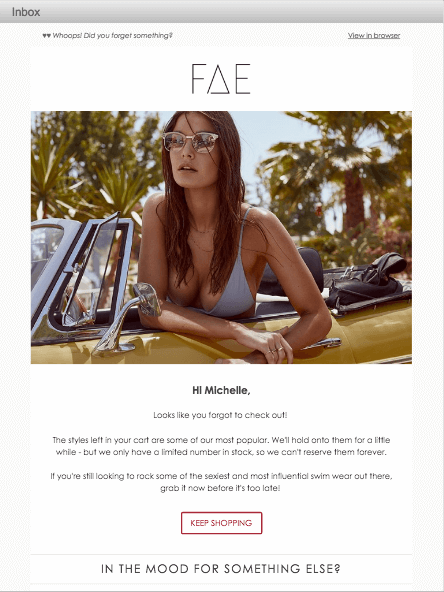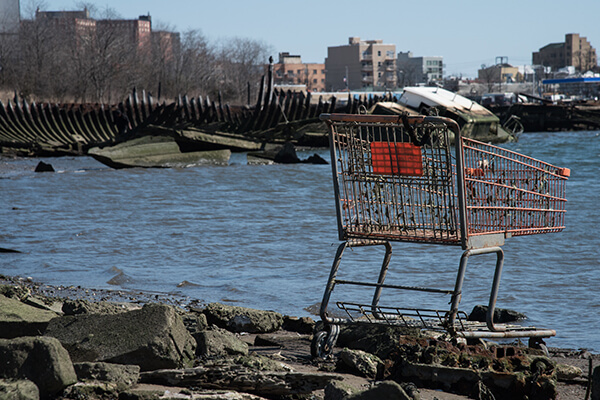If you’re running your own online store, you’re probably already mildly peppery about how many people actually visit your website and add something to their online cart, then leave before they complete their purchase. In fact, Monetate Ecommerce Quarterly Report, Q4 2017, showed that the global average ‘add to cart’ rate was between 10-11%.
Now that doesn’t seem so bad at all, does it? You can’t expect all your visitors to purchase.
Problem is, the average conversion rate was just 3-4%. Only a fraction actually end up completing their order.
That means roughly one in every ten visitors adds something to their online cart. But only one in thirty actually convert.
Your rates may be higher or lower, depending on your product, industry and a whole manner of different variables. But no matter what your business, you’re almost certainly inundated with heartbreakingly indecisive customers; the aisles of your online store full of deserted trolleys and baskets.
So what do we do about these would-be customers?
Luckily, a good portion of them can be won back over if you know a few tricks of the trade. Let’s take a look how….
Why do people abandon carts?
Let’s start at the very beginning. Why do people abandon their carts in the first place?
SaleCycle took a look at the data from abandonment surveys, and found the six most common reasons people gave for leaving without purchase:
- 34% said they were just looking,
- 23% said there was an issue with shipping,
- 18% wanted to compare prices,
- 15% decided to buy in store,
- 6% left due to a lack of payment options, and
- 4% experienced a technical issue.
Like myself, I’m sure you too have left without completing a purchase for one (or all) of these reasons in the past.
That being said – people don’t just throw items into their cart willy-nilly. There’s a reason they clicked ‘add to cart’ – and that reason is, they’re seriously considering purchasing it. These leads aren’t just ‘hot’ – they’re thermonuclear. It would be insane to not take the opportunity to try and tip that sale over the line.
Calculating your Abandoned Cart rate
You can easily calculate your own abandoned cart rate by dividing the number of completed purchases by the number of shopping carts created. Then multiply the result by 100.
For example, with 100 completed purchases and 250 shopping carts created, you would have 0.4 times 100 which equals a 40% conversion rate.
That’s a lot of customers that came way too close to conversion to just give up on. So what can we do about it?
Our solution: Email automation
Email is, and will always be, a marketer’s best friend. Especially in ecommerce, where it still maintains the highest return on investment of any marketing channel.
In fact, according to Klaviyo’s Abandoned Cart benchmark report, the average performance for abandoned cart emails is roughly:
- Open rate of 41.18%
- Click rate of 9.50%
- $5.81 average revenue per recipient
Why such great results? Well – it all comes down to relevance. Being such a flexible communication channel, we can use integrations and dynamic content to make email do some pretty amazing stuff (a little more on this later). Even better, with the right software platforms, we can automate email to send at just the right time, to exactly the right customer.

But before we go any further and start setting up your own automated flow, you’ll need to ensure you have:
- An ecommerce platform that allows integrations,
- An email automation platform that can sync up with your ecommerce platform, and allows you to create flows or automations.
- A healthy database of subscribers.
Our two personal favourite platforms for recovering abandoned carts are the Shopify ecommerce platform, and Klaviyo’s marketing automation platform. These work together seamlessly to create email automations that fire off perfectly without any hassle or custom coding.
If you are already using these platforms, you can set up your Klaviyo/Shopify integration here. Alternatively, have a look around and see if there is an app or integration for your existing ecommerce store and marketing platform.
Setting up an integration between the two is not just essential for this abandoned cart recovery strategy – but also incredibly beneficial for a tonne of different purposes. Once you’ve set up the connection, you’ll have the data available in your email marketing platform to segment your subscribers based on their purchase history, website sessions and more. Your capacity for highly-relevant targeting will be instantly better by several orders of magnitude.
Abandoned Cart series structure
Okay now we’ve set up our integration, let’s discuss the structure of our series.
Entrance conditions – bringing cart deserters in.
Klaviyo already has a default Abandoned Cart flow set-up. Some people simply turn this on as soon as their software is out of the box and watch as default emails fire off automatically.
However – we would strongly recommend getting a little bit more involved than that.
Depending on your product range and industry, your Abandoned Cart series might look very different. Using their default flow is the easiest way to get started – it ensures Abandoned Cart emails are only going to those who have started a checkout, but have purchased zero times since starting the flow – but you will need to do some serious renovating to your timing and email content.
When to send the first email?
You want to strike when the iron is still hot – but you don’t want to rush at a customer as soon as they’ve closed the webpage. Generally, waiting between 12 and 24 hours before sending the first email is most advisable. However, this could vary depending on your product offering.
How many times should you follow up?
A single abandoned cart reminder email is better than nothing. But leaving it at just the one email means you might be leaving revenue on the table.
Klaviyo have analysed how many emails your series should contain to generate the best results – and their findings were clear. Despite the first email in a series always being the top performer, brands who sent follow-up emails made most revenue overall. Second and third emails maintained healthy open and click-through rates, and continued generating steady sales. However, fourth and fifth emails showed diminishing returns, and were more likely to push unsubscribes.
These two extra emails should drip into your customer’s inbox slowly – you don’t want to rush them or seem pushy. After you’ve sent your first reminder, wait a day or two longer before following them up again.
What makes a great Abandoned Cart email?
Now we have your automation series all set up and ready to fill with content. So what makes a successful, highly converting abandoned cart email?
Personalisation and dynamic content
All great email uses personalisation. Not in a gimmicky way, but to increase the relevance of the content.
And with personalisation, you can actually populate your email with the important and relevant reminder for a customer: exactly what is left in the cart.
Using your new ecommerce integration, you should be able to easily pull data from your ecommerce platform into the emails you send themselves. This will allow you to fill up emails dynamically with the right products for individual customer.
Thank you, science!
Being able to see the items they left behind will help to remind your customers why they were initially thinking of purchasing in the first place, and greatly increase your chances of conversion.
Campaign messaging
Consider the following two questions when writing any email copy:
- Who are your target audience?
- What problems does your product or service solve?
The importance of your campaign’s messaging can’t be understated. Your copy should empathise with the day to day life of your target audience, push the value of your product, and remain consistent with your brand’s voice and tone.
Email – especially abandoned cart reminders – should also be kept quite brief. When plugged into their devices, people like to scan text quickly. Keep your copy short, and your calls to action plentiful and hard-hitting.
Incentives and discounts
Simply reminding a customer that they have items still in their cart works well if done in a timely fashion. Although, depending on your pricing, if you really want to increase your conversion rates, you might like to consider offering a discount.
Unsurprisingly, emails that offer a discount or coupon code have an above-average open rate (44.37% by Klaviyo’s calculations) and a higher click-through rate (10.85%).
Likewise, considering that 23% of cart abandoners complained of shipping issues, offering free shipping in your abandoned carts is another incredibly high performing way to salvage these lost sales.
If you can afford to, offer your client a small incentive to complete their order. (But it’s advisable to leave this until your second or third email, to ensure you’re not throwing away revenue you could have made with just a reminder).
Subject line
One last consideration: your subject line. This is the first part of your email customer’s will engage with, and it’ll make or break your open rate.
Studies have shown that abandoned cart subject lines focused around the sentiment ‘you’ve left something behind’ achieved the best results. This could be due to the appeal of the vagueness and mystery – it encourages users to click through. However, if you are offering a discount, subject lines that contained a dollar or percentage sign, ‘free shipping’, or some other incentive had slightly lower open rates, but their click through rates were still very high.
As before, whatever you go with, make sure it is on brand. The same, high-performing sentiments can and should be tweaked to suit your business’ unique voice and tone.
Conclusion and key takeaways
Implementing a great email automation strategy can be difficult – but the return on your investment is unbeatable.
One of our clients, Fae Swim, recovered a full 7% of all their abandoned carts after we implemented an email automation series for them. That is an incredible result – and continues to generate thousands in added revenue.
I bet you’re itching to get out there and start building your own abandoned cart series now, so let’s wrap this up with a few final takeaways:
- Only one in thirty people who add to their cart actually complete their purchase.
- Email has the best ROI and conversion rate of any marketing channel.
- Integrating your ecommerce and email marketing platform is not just great for Abandoned Carts, but a whole smorgasboard of other data-driven applications and automations. Check out a few examples!
- Keep your email series well spread out and brief – don’t spam your potential customers!
- Use personalisation, great copy and hard-hitting CTAs
- Consider offering a coupon or discount incentive if you can afford it.
If you need a hand implementing an Abandoned Cart series of your own, integrating your email and ecommerce platforms, or you’d just like a chat – get in touch with us today! One of our strategists would love to help take your digital marketing to the next level.




